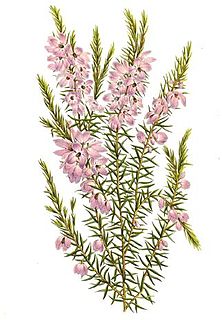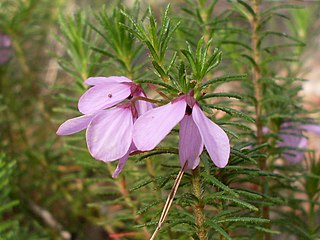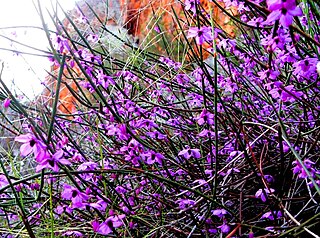Rupicola is a small genus of flowering plants in the family Ericaceae. The species are endemic to New South Wales in Australia.

Tetratheca is a genus of around 50 to 60 species of shrubs endemic to Australia. It is classified in the botanical family Elaeocarpaceae, now known to encompass the family Tremandraceae, which the genus originally belonged to. It occurs throughout extratropical Australia, and has been recorded in every mainland state except the Northern Territory.
Budawangia is a monotypic genus of flowering plants in the family Ericaceae. The sole species is Budawangia gnidioides from New South Wales. The genus was formally described in 1992.

Tetratheca pilosa is a flowering plant in the family Elaeocarpaceae, endemic to Australia. It is a small shrub found in dry sclerophyll forests, open heathlands and woodlands of Australia. It was first recorded in 1805 by French botanist Jacques Labillardière.

Leptospermum rupicola is a low-growing shrub that is endemic to New South Wales where it grows near cliffs. It has thin, rough bark, narrow lance-shaped leaves, white flowers and relatively large fruit that remain on the plant at maturity.
Epacris gnidioides is a species of heath endemic to the Budawang Ranges of New South Wales, Australia. Previous names are Rupicola gnidioides and Budawangia gnidioides.
Tetratheca deltoidea, also known as granite tetratheca, is a species of plant in the quandong family that is endemic to Australia.
Tetratheca similis is a species of plant in the quandong family that is endemic to Australia.
Tetratheca retrorsa is a species of plant in the quandong family that is endemic to Australia.
Tetratheca remota is a species of plant in the quandong family that is endemic to Australia.
Tetratheca paucifolia is a species of plant in the quandong family that is endemic to Australia.
Tetratheca parvifolia is a species of plant in the quandong family that is endemic to Australia.
Tetratheca fasciculata, also known as Cronin's Tetratheca, is an extinct species of plant in the quandong family that was endemic to Australia.
Tetratheca decora, also known as black-eyed susan, is a species of plant in the quandong family that is endemic to Australia.

Tetratheca neglecta is a species of plant in the quandong family that is endemic to Australia.
Tetratheca labillardierei is a species of plant in the quandong family that is endemic to Australia.
Tetratheca insularis is a species of plant in the quandong family that is endemic to Australia.
Tetratheca nephelioides is a species of plant in the quandong family that is endemic to Australia.
Tetratheca harperi, also known as Jackson Tetratheca, is a species of flowering plant in the quandong family that is endemic to Australia.

Tetratheca aphylla, also known as the Bungalbin Tetratheca, is a species of flowering plant in the quandong family that is endemic to Australia.




